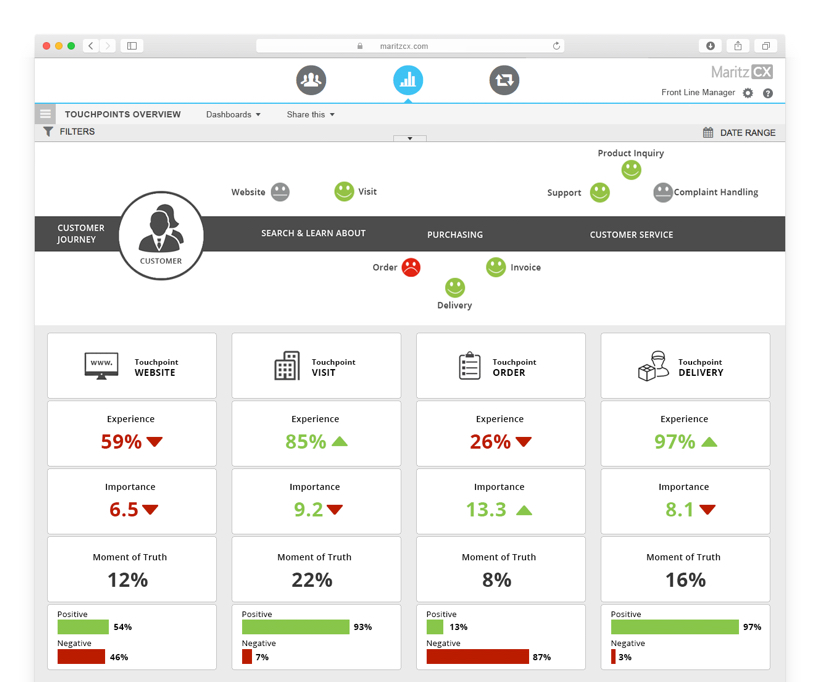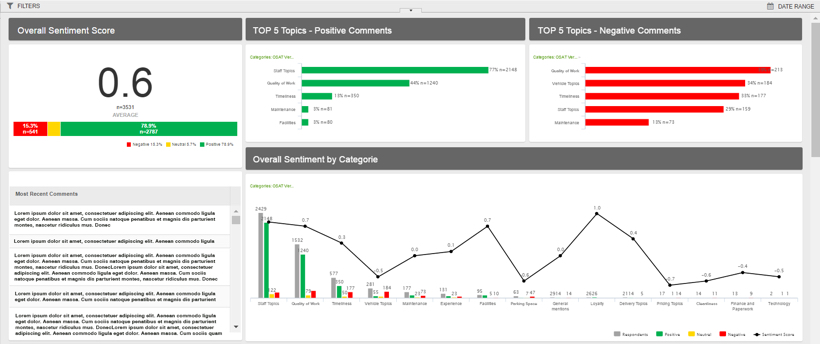
Image by: portishead1, ©2017 Getty Images
As a customer-centric business, decisions should always be made based on the benefits for customers. This requires a precise understanding of the customer experience at various interaction touchpoints and where the opportunities for improvement exist.
From the customer’s perspective, touchpoint evaluations should be focused on a particular experience. This is also referred to as transactional or event-oriented feedback in which the exclusive goal is to obtain feedback on an interaction that just occurred. Because the experience is still fresh, the evaluation is not only reliable but also more detailed than an evaluation that is based on a memory from some time ago. This enables the company to react in a timely manner to a negative experience so as to rescue a positive outcome from the occurrence.
Touchpoint evaluation and management software is often deployed as:
- A tool for employees with customer contact to improve individual customer relationships and identify new business opportunities
- A planning instrument for realizing continuous improvement on a process level
- A management tool for monitoring key figures
- A benchmarking instrument for internal performance evaluation
Components of Customer Experience Software
Contact point management software should be able to support the complete process, from data collection to taking action on the results. There are three primary components to the software:- A survey application
- Reporting and analytics functions
- Tools for action planning and execution
Survey Software
A touchpoint survey is conducted on overall satisfaction, brand perception, and the specific contact point. Therefore, the survey software should be able to fully implement the company’s corporate design rules. A clear and compelling design has a positive impact on relevance and participation. It is not sufficient for online surveys to be only mobile compatible; they have to be principally designed for mobile devices. This is especially important for contact point-related customer surveys, which are designed to be short specifically for responses sent via a mobile device. The software has to meet the technical requirements for graphics and text elements to appear correctly and completely and be easily readable on any type of device.The prerequisite for triggering a survey is the transmission of the contact information to the touchpoint software. Various data transfer paths are available, ranging from the file upload and download via a Secure File Transfer Protocol (SFTP) page to a direct, permanent connection via a real-time interface (i.e., web service/API). The internal system providing the survey-relevant data is frequently a customer relationship management (CRM) solution, which records the contact point experience in addition to customer data, and triggers the survey process.
The following data should be transmitted to the touchpoint software in a predefined format (like .CSV):
- Customer’s contact data (name, email, etc.)
- Specification of contact point visited so the specific questionnaire for that point is utilized
- Other customer-related data of interest for individualizing the survey and subsequent reporting in the touchpoint software
Reporting and Analytics Functions
Convenient access to information, well-organized presentation of results, and custom reports for different stakeholders are essential for getting users to engage with customer experience content. With role-based access and rights, users only see the information specifically relevant to them.In contrast to a one-time survey, feedback data is gathered on an ongoing basis via continuous contact point measurement. Accordingly, a software platform for this purpose must be able to show constantly changing results in real time.
The Dashboard Provides Comprehensive Overview
A dashboard showing the most important information on central contact points in the customer journey indicates where the company currently stands at a glance. In addition to key performance indicators (KPIs), such as Net Promoter Score and overall satisfaction, diagnostic elements track what’s behind an evaluation.To gain an overall understanding of the customer experience at a given contact point, all feedback sources should be factored into the analysis. Thus, the reporting portal of a touchpoint platform must be able to show data from different sources, including social media and operational metrics, simultaneously and in integrated fashion.

Automated Text Analysis
Unstructured comments are important for understanding what customers want and why they have given a particular evaluation. These include feedback comments on evaluation page sites and in social media. Unstructured comments have to be evaluated in an aggregated form to identify systematic deficiencies. This requires software to utilize linguistic techniques for sophisticated text analysis in the local language. Natural language processing (NLP) and statistical methods enable the program to “understand” what is in the text. The accuracy of text analysis programs can be as high as 80% or more, thus, being at least as accurate as human coders. In addition to the categorization, text analysis software can usually register the sentiment behind a statement. This involves assessing whether the feedback is positive, neutral, or negative.
Tools for Action Planning and Execution
In regard to taking action as part of touchpoint management, a fundamental distinction is made between the individual level and the aggregate level.Close the loop: Responding on the individual customer level
As legally permissible, the company can respond directly to feedback by contacting the customer. Concerns and questions are relevant here that have nothing to do with the actual contact point experience. A timely reaction demonstrates a special appreciation for the customer. Touchpoint software is utilized to identify the particular customer contact with a priority for follow-up. An alert and consequential activity may be triggered on the basis of such factors as the customer's response to a key metric like NPS or willingness to recommend being in the detractive range. Ideally, multiple triggers are defined per questionnaire, including identified key points in unstructured comments.
Touchpoint management software automatically ensures that a corresponding notification goes to the responsible administrator without lag time when a case is generated. It is essential for the employee to have all relevant information and clearly understand the customer’s concern. Cases are generally handled either within the CRM system or directly via the touchpoint management software if a case management module is integrated. Case management actively assists employees with customer contact by optimizing individual customer relationships to directly impact growth and loyalty. For management, it is a valuable source of information to identify a potential need for training and development.
Action plan for fundamental improvements
Action planning on the aggregate level is about identifying the potential for improvement at a given contact point and ways to increase customer satisfaction. Dashboards should enable the identification of relative weaknesses. Ideally, actions can be initiated and tracked directly in the software. The software ensures that the objective behind the action is clearly defined, the causes known, responsibilities and time constraints determined, and all hindering factors are fully transparent, whether internal or external or of a regulatory or legal nature. The touchpoint management software reveals what results come from specific activities and how successful the company is in improving its customer focus. This allows quantifying return on investment in software-based touchpoint management.
Technical Success Factors
The technical requirements for touchpoint management software depend on the industry in question and the nature of the company’s customer relationships. The following elements are generally required, however. The software must offer flexible methods for integration and automated connection to existing systems. File-based formats (flat file formats like .TXT, .CSV, .SPSS, .JSON, etc.) and connections via web services are generally provided. Frequently, an SFTP folder (encrypted communication via Secure Sockets Layer or Transport Layer Security) is utilized for file sharing, enabling easy automation of import and export processes. Integration must be via real-time interfaces to enable maximum data processing speed.The following technical features are required for high-performing touchpoint management software:
- SaaS with regular updates, ensuring the investment remains relevant and useful going forward
- Targeted support for preferred communication channels
- Flexible data import and integration interfaces
- Easy adjustment of data visualizations (dashboards)
- Automated text analysis of unstructured feedback
- Real-time reporting
- Integrated tools for action taking
Christopher Harms has assisted companies with managing complex information technology (IT) projects for more than 15 years. As a Solutions Consultant for , his day-to-day challenges include intelligently combining different data sources, deriving insights, developing additional communication channels for touchpoint evaluation, and providing results to user groups.
Oliver Skeide is Director of Expert Services in EMEA at MaritzCX. In this role, he is responsible for consulting services, training, and studies on the topics of touchpoint management and customer experience (CX). He has many years of experience in CX and in classic marketing and consumer research.










